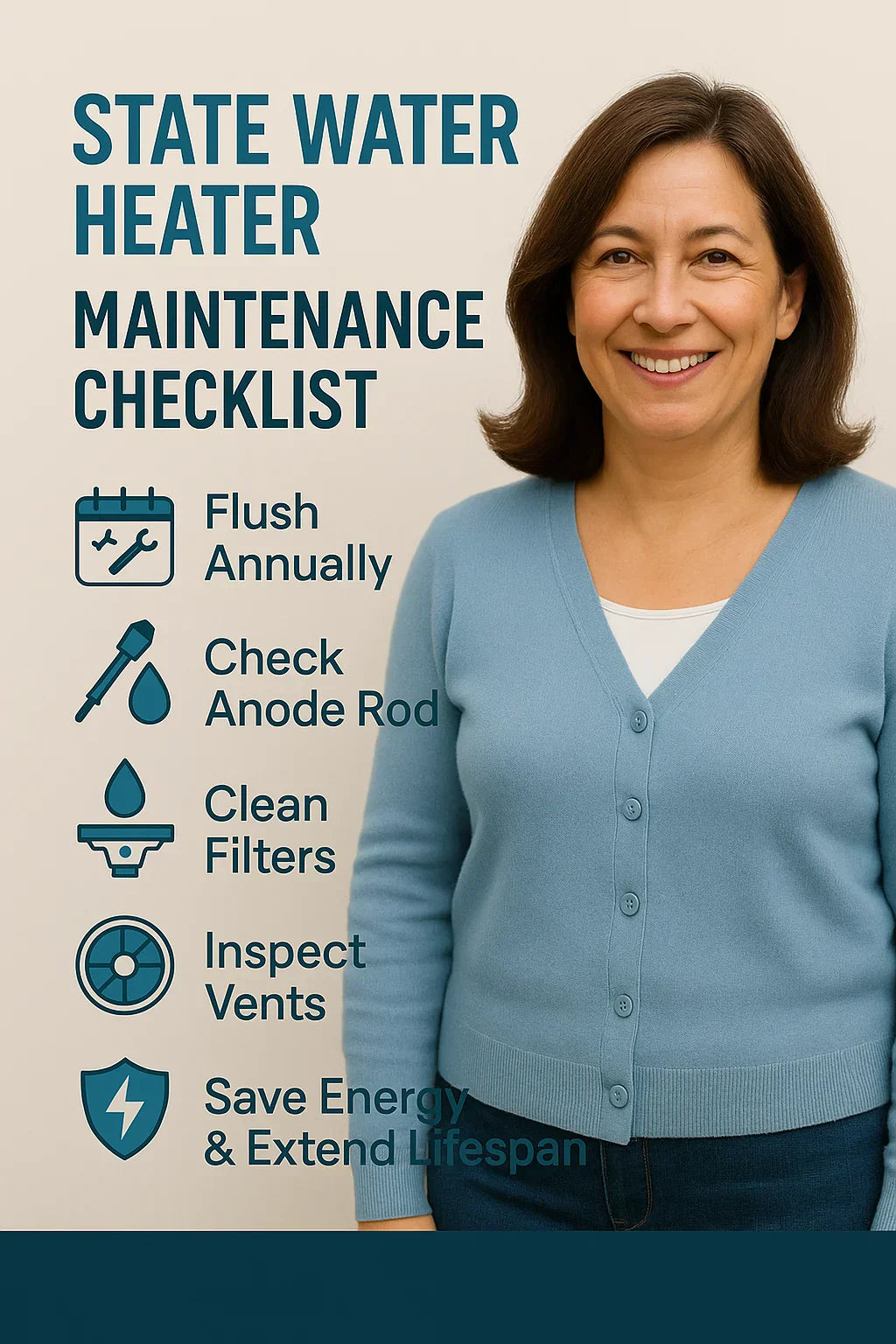Your State water heater is a long-term investment in your home’s comfort and efficiency. With proper maintenance, you can extend its lifespan, reduce energy costs, and minimize the risk of inconvenient breakdowns.
This guide will walk you through tank, tankless, gas, and electric State water heater maintenance, helping you keep your system running smoothly for years.
🗓️ Recommended Maintenance Schedule
Monthly
-
Check for leaks around the unit.
-
Ensure clear space around the heater.
-
Listen for unusual noises.
Annually
-
Flush tank models to remove sediment.
-
Check the anode rod for wear.
-
Inspect the pressure relief valve.
-
Clean or replace air and water filters on tankless models.
Every 3-5 Years
-
Replace the anode rod if needed.
-
Inspect venting and exhaust systems.
For official recommendations, see State Water Heaters Maintenance Resources.
💧 Flushing Your State Tank Water Heater
Sediment buildup reduces heating efficiency and shortens your tank’s lifespan.
Steps:
1️⃣ Turn off the power (electric) or set the gas valve to pilot (gas).
2️⃣ Attach a hose to the drain valve and place the other end in a safe drain area.
3️⃣ Open the drain valve and a hot water tap to allow draining.
4️⃣ Let it drain completely, then close the valve.
5️⃣ Refill the tank and restore power.
Tip: Perform this annually or every 6 months in areas with hard water.
Learn more at Energy.gov - Water Heating.
🔩 Checking and Replacing the Anode Rod
The anode rod protects your tank from rusting by attracting corrosive elements in the water.
-
Check every 1-3 years.
-
Replace if the rod is less than 0.5 inches thick or coated in calcium.
-
Extend your tank’s lifespan significantly with timely replacements.
For guidance, see Family Handyman - Replace Water Heater Anode Rod.
🔥 Gas State Water Heater Maintenance
Pilot and Burner Inspection
-
Check the pilot light for a steady blue flame.
-
Inspect the burner for debris and clean if necessary.
Venting System
-
Ensure the vent pipe is free of obstructions.
-
Check for corrosion or leaks around connections.
Leak Checks
-
Use a soap solution around fittings to check for gas leaks.
⚡ Electric State Water Heater Maintenance
Heating Element Check
-
Sediment can build up on heating elements, reducing efficiency.
-
Test elements for functionality during annual maintenance.
Thermostat Accuracy
-
Check water temperature settings (recommended: 120°F for efficiency and safety).
-
Test thermostat functionality if temperature fluctuates.
Safety Tip: Always turn off power before inspecting electrical components.
🚿 Maintaining Your State Tankless Water Heater
Annual Descaling
-
Hard water can cause scale buildup inside the heat exchanger.
-
Use a descaling pump and vinegar solution annually to flush the system.
Inlet Filter Cleaning
-
Remove and clean water inlet filters to maintain flow efficiency.
Venting and Air Intake
-
Inspect for blockages or buildup.
-
Ensure clearances around the unit remain unobstructed.
For tankless system maintenance, see Energy Star - Tankless Water Heaters.
🧰 Signs Your Water Heater Needs Professional Attention
-
Inconsistent water temperatures.
-
Popping, rumbling, or hissing noises.
-
Rusty or discolored hot water.
-
Water leaking around the tank or connections.
-
Error codes on tankless units.
If you notice these issues, schedule a professional inspection promptly to prevent major damage.
🌿 How Maintenance Saves Energy and Money
✅ Removes sediment for better heat transfer.
✅ Maintains efficient water flow and heating rates.
✅ Prevents overworking of heating elements and burners.
✅ Reduces standby heat losses.
✅ Lowers monthly energy bills.
A well-maintained State water heater can last 15+ years for tanks and 20+ years for tankless models.
✅ Conclusion: Protecting Your Investment
Regular maintenance of your State water heater will:
-
Extend your unit’s lifespan.
-
Save energy and money.
-
Ensure safe and efficient operation.
-
Reduce the risk of emergency repairs.
Next Steps:
-
Create a maintenance calendar reminder.
-
Perform monthly and annual checks.
-
Flush tank units and descale tankless models regularly.
-
Check your anode rod and replace as needed.
-
Contact a licensed professional for an annual inspection.
Explore replacement parts, filters, and upgrade options for your State water heater on The Furnace Outlet.
With proactive care, your State water heater will continue to provide reliable, efficient hot water for years to come while saving you money on energy bills.
In the next topic we will read more about: Troubleshooting Common State Water Heater Problems







